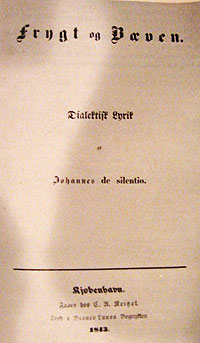 First edition title page | |
| Author | Søren Kierkegaard |
|---|---|
| Original title | Frygt og Bæven |
| Language | Danish |
| Series | First authorship (Pseudonymous) |
| Genre | Christianity, philosophy, theology |
Publication date | October 16, 1843 |
| Publication place | Denmark |
Published in English | 1919 – first translation [citation needed] |
| Pages | ~200 |
| ISBN | 978-0140444490 |
| Preceded by | Two Upbuilding Discourses, 1843 |
| Followed by | Three Upbuilding Discourses |
Fear and Trembling (original Danish title: Frygt og Bæven) is a philosophical work by Søren Kierkegaard, published in 1843 under the pseudonym Johannes de silentio (Latin for John of the Silence). The title is a reference to a line from Philippians 2:12, which says to “continue to work out your salvation with fear and trembling.” The Philippians verse is sometimes thought to reference Psalm 55:5, which says, “Fear and trembling came upon me.”[1]
The work is an extended meditation[2] on Genesis 22, also known as the binding of Isaac. Silentio attempts to understand Abraham’s internal psychological state during his three-and-a-half-day journey to Moriah. The text attempts to demonstrate how it is not easy to understand Abraham’s actions through ethical categories like Sittlichkeit or the universal. Instead, Silentio posits that Abraham can only be understood through a new category called faith.
Fear and Trembling speaks of many of Kierkegaard’s most well-known concepts, such as the absurd, knight of faith, single individual, teleological suspension of the ethical, three stages, tragic hero, and so on.
- ^ "Psalm 55:5 Fear and trembling to grip me, and horror has overwhelmed me".
- ^ “Fear and Trembling comprises a sustained meditation on the Hebrew patriarch Abraham, whom Johannes recommends to his readers for urgent reconsideration. His avowed aim in doing so is to mobilize Abraham in the service of his campaign to address the spiritual crisis that afflicts European (or at least Danish) modernity.” Daniel Conway, “Introduction,” in Kierkegaard’s “Fear and Trembling”: A Critical Guide, ed. Daniel Conway, Cambridge Critical Guides (Cambridge University Press, 2015), 2.